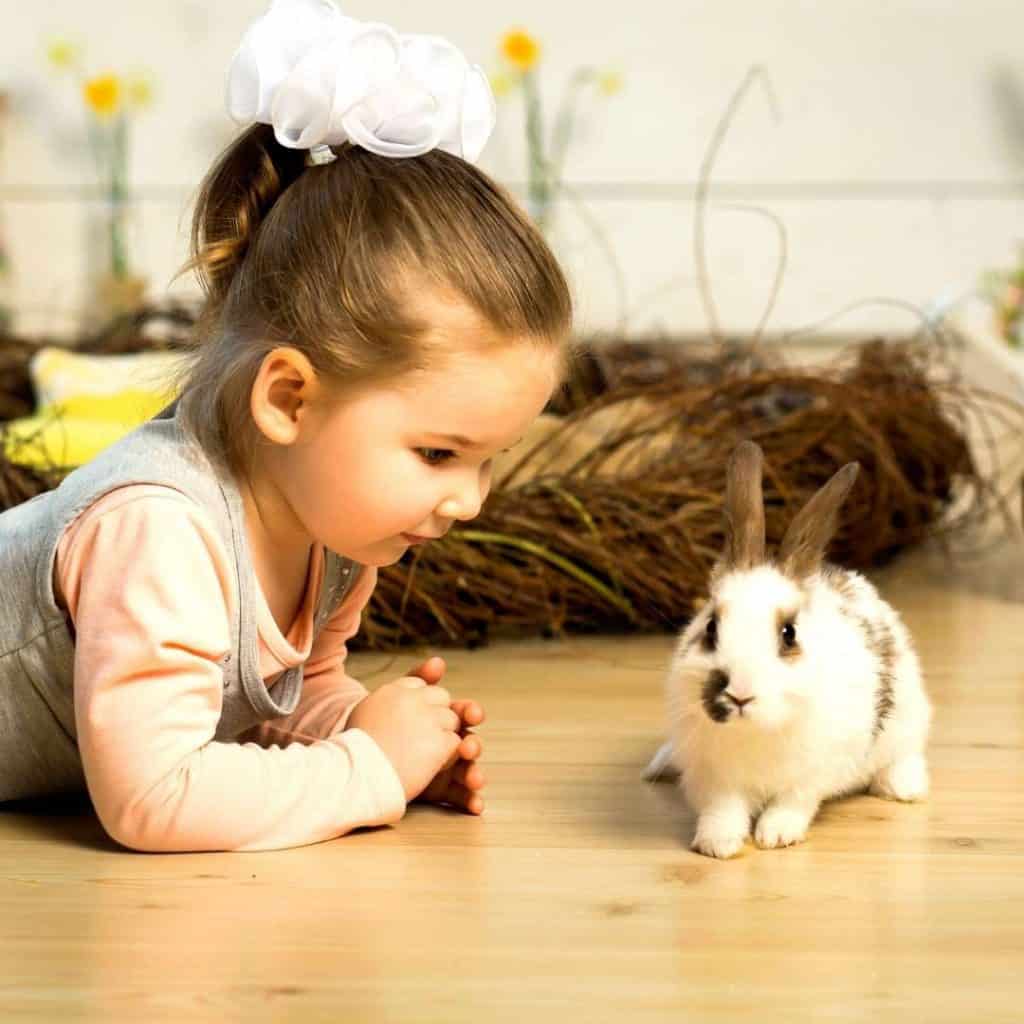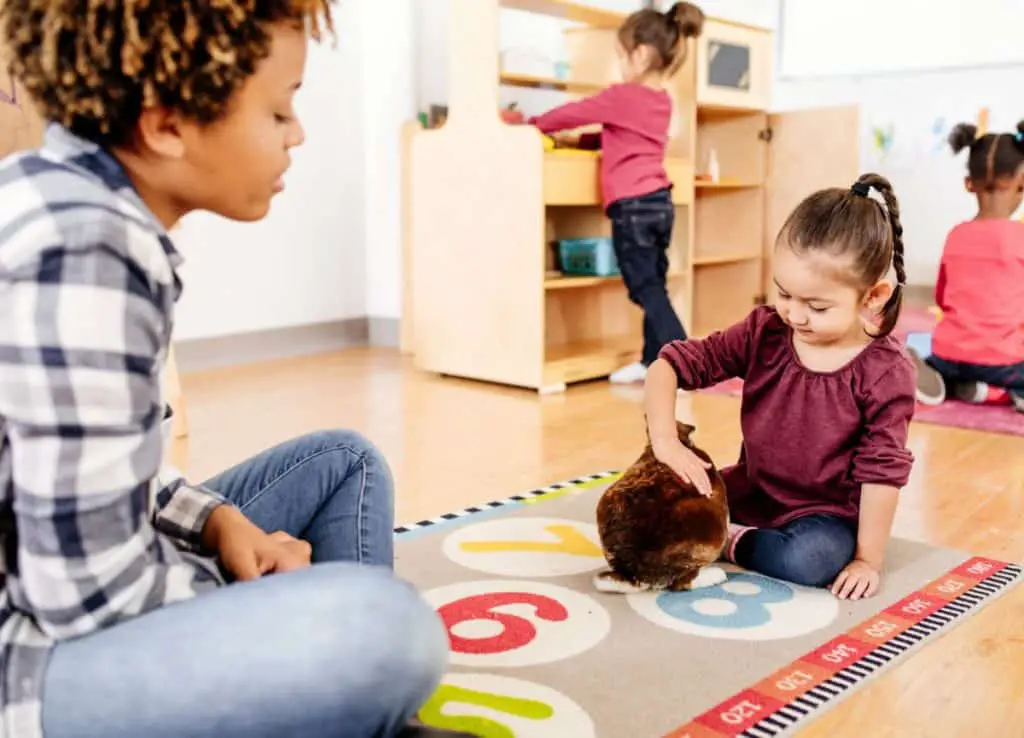Disclosure: We may earn money or products from the companies mentioned in this post.
Introducing a pet rabbit to a small child means introducing change. Change can be stressful both for the new bunny and your kid. But it doesn’t have to be. Follow these 5 tips for introducing your child to a new pet rabbit, and you’ll all be living in harmony in no time.

9 Tips To Introduce Kids to Pet Rabbits
1. Involve Children In The Decision-Making
Since you will be getting a bunny as a pet for your child, it is better that they are involved in most aspects of the decision.
Ask them what they think, what they are looking for in a bunny, and what they are willing and capable of doing to maintain that new pet rabbit.
Having the entire family aligned will not only help you come up with the best decision but will also facilitate family teamwork and bonding. Besides, involving children in decision-making empowers them. It makes them feel valued and validated thus raising their self-esteem and confidence.
2. Set Reasonable Expectations
A lot of kids can have pretty unreasonable expectations of what it’s like to have a pet rabbit. Make sure that they know that they are not getting Bugs Bunny as a pet!
Also, make sure that they know that rabbits are timid creatures until they get to know and trust you. This means that you’re not going to be playing with a new bunny the same way you might play with a new puppy when you first get them home.
Instead, you’re going to be earning your new bunny’s trust while showing them that their new home is a safe place that is danger-free…we’ll talk about this more later.
However, in time, that pet bunny will play with you in a lot of the same ways that a cat or dog will!
Before you decide to get a rabbit, you should read this article about the Pros And Cons Of Pet Rabbits.
3. Record Responsibilities
Rabbits don’t require as much exercise as dogs, they are not low-maintenance pets.
For example, they need to always have clean hay available as part of a healthy rabbit diet, and they need their hutches/litter boxes cleaned. Thus, it is important that before getting a bunny parents and the children should have a clear alignment on who is responsible for the tasks that are pet-related. This also teaches the children about responsibility and accountability.

4. Strive For Calmness
Getting a new bunny is exciting for anyone, but for small children, it can be crazy exciting. And while rabbits make great pets for children, they do not do well with crazy.
Rabbits are naturally prey animals, which means they are always on the lookout for rabbit predators. And when on the lookout for anything that might be out to eat you, loud noises and sudden movements are going to seriously scare a bunny that is still unsure about its new living arrangements.
5. Sit & Wait
When you are first introducing your children to their new pet rabbit, we strongly recommend the sit-and-wait strategy. As a matter of fact, we recommend this strategy for introducing your rabbit to anyone new.
For example, if your kids love to be read to, why not calm your kids down and get settled on to the floor for some reading time in your rabbit’s play area. Then once everyone is calm and ready, quietly go over and open the ramp to your rabbit’s indoor hutch and then head back over to your kids and start reading their favorite books.
As you calmly read, your new bunny’s curiosity will get the better of him and he’ll eventually wander down the ramp and explore his expanded area.
The trick here is to let him explore without being grabbed at, or even petted…especially make sure he’s not chased like someone is getting ready to eat him!
After a few sessions like this, your new bunny will adventure closer and closer to you and the kids. You can speed this process up by laying some rabbit treats on the floor close to your reading area. Each time he eats the treats, just move the treats closer until they are finally setting right on your leg.
If you do this twice a day, within a week your new bunny will be eating treats out of your hand and beginning to enjoy being gently touched.
6. Learn Rabbit Body Language
If you and your children can learn basic rabbit body language you’ll be able to know if your bunny feels safe or threatened. When your bunny is feeling threatened, you need to give him space and don’t try to introduce new interactions.
However, when your bunny begins demonstrating behavior that indicates they feel safe and secure in their new environment, then you can begin to introduce more fun interactions including petting, holding, and trick training.
You should start by reading this article about Pet Rabbit Body Language so you can teach the basics to your children.
7. Stick To A Schedule
Rabbits are creatures of habit. A pet bunny’s days are filled with activities that generally follow a pretty set schedule.
Thus, it is important that their caretakers stick to a schedule when interacting with your new pet rabbit
This means that your kids are going to not mess with the new bunny after X pm and before X am. This usually is pretty close to sunset and sunrise, as rabbits are not nocturnal, but are instead crepuscular which means they are most active during the twilight hours.
Likewise, you’ll want to encourage your kids to feed and play with their bunny at about the same time each day. This schedule will make it easier for your children to remember their responsibilities and for your bunny to fall into a natural rhythm in their new home.

8. Supervise All Play Time
Rabbits are small and fragile animals. And just like with small puppies or kittens, small children should be closely supervised when playing with such fragile animals.
You just don’t want to have a new bunny become scared of your kids or, even worse, be accidentally injured.
As you kids learn how to interact with their new pet and as the rabbit learns to trust the kids, they’ll be fine playing together alone…but until that time, supervising that play is your responsibility.
9. Limit The Chaos
Keep it simple as your new bunny is bonding and integrating into your family.
If you have a larger family, introduce the bunny to just a few of the kids at a time.
If your family has other pets, let them be the last to meet the new family member.
Bringing a new bunny into a situation where a bunch of hands is reaching for it while the dog barks and the cat stalks it is a recipe for a terrified bunny which is going to definitely slow down the bonding process that will make your bunny a wonderful part of your family for years to come.
We hope this article was helpful as you think about how you’ll introduce your children to a new pet rabbit.
If you are considering getting a pet rabbit for your kids, here are a few more articles that you will find helpful.

